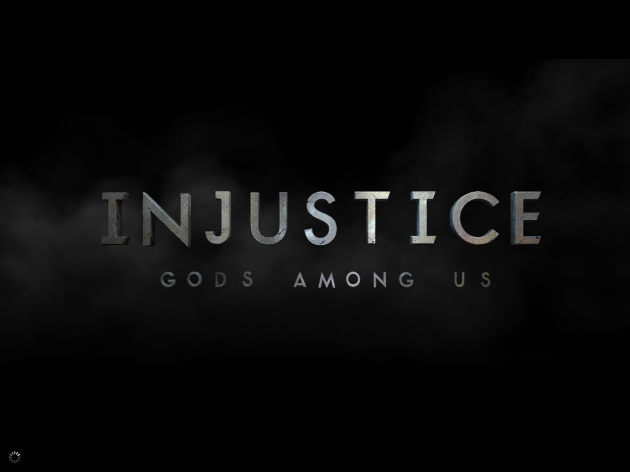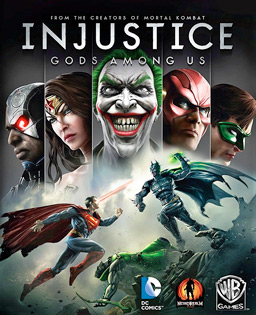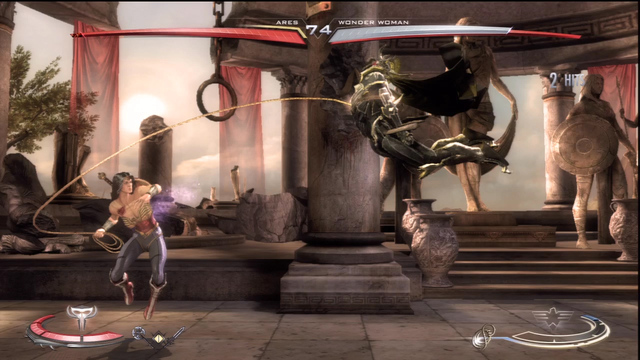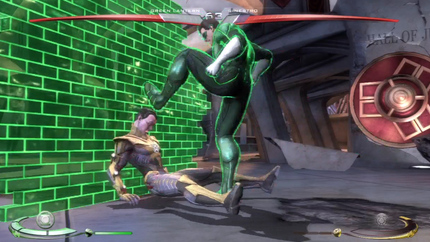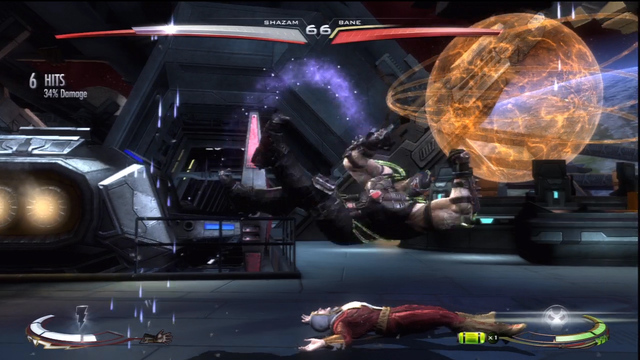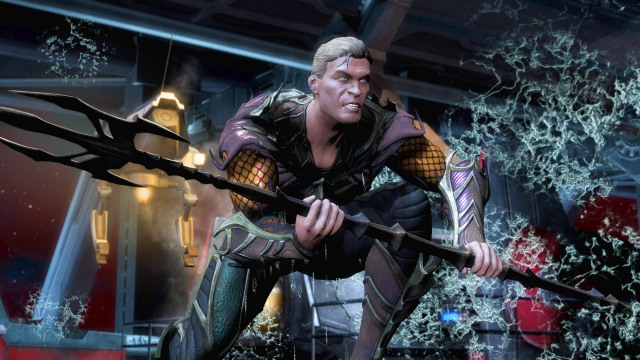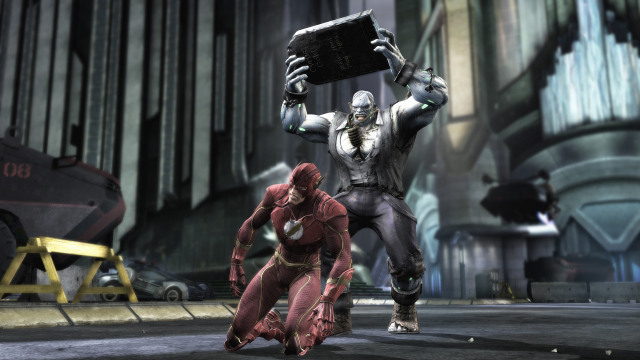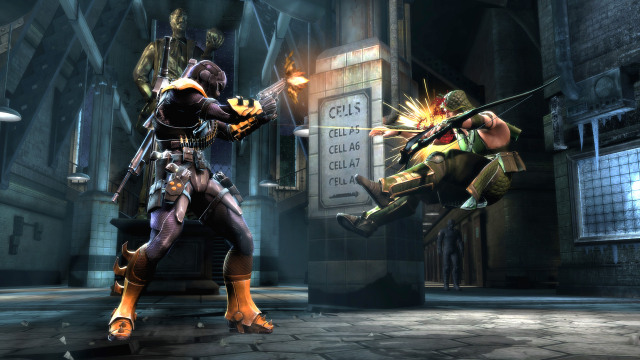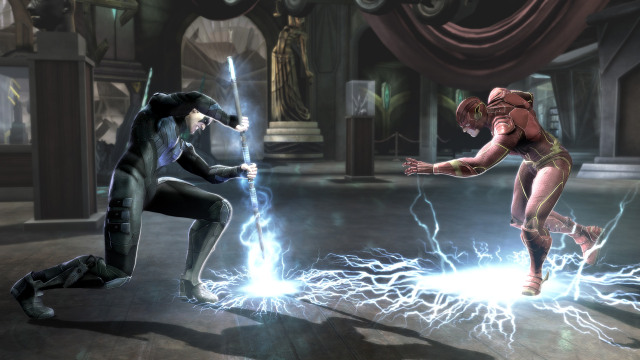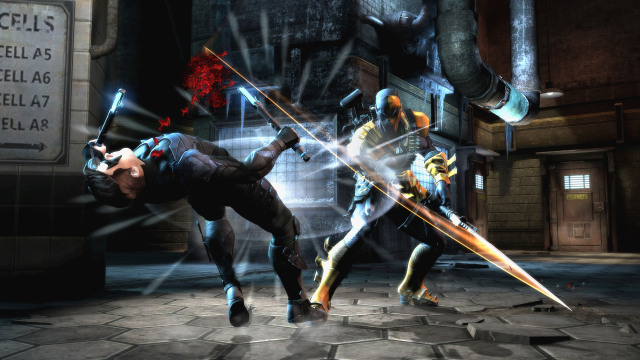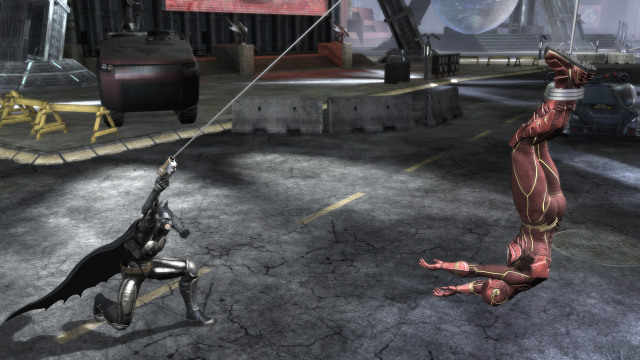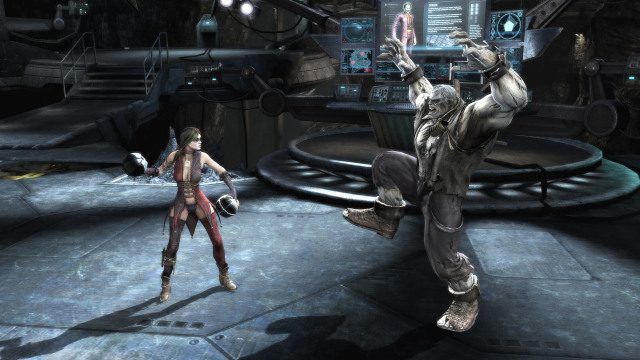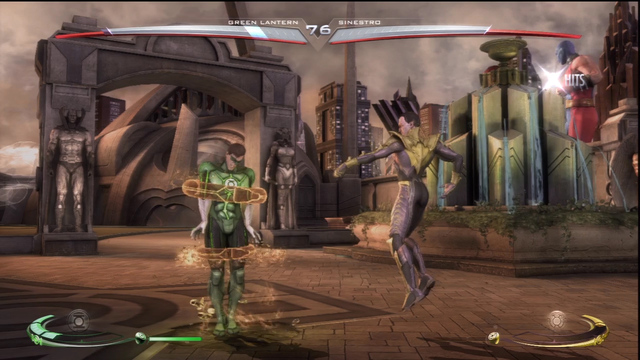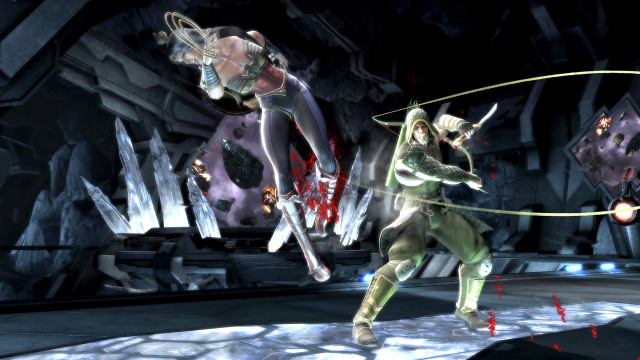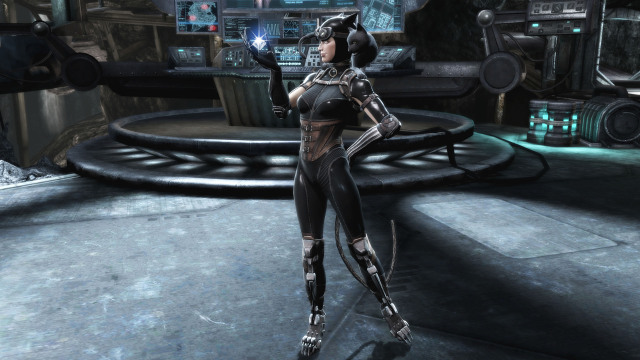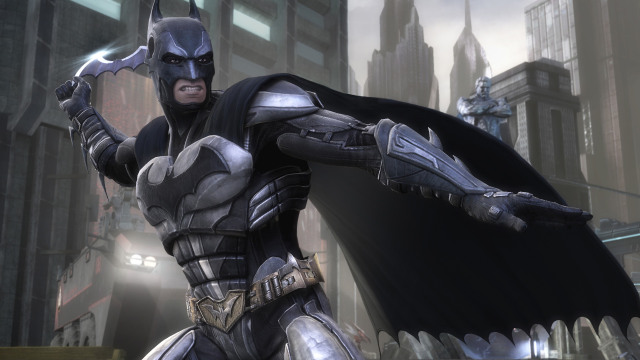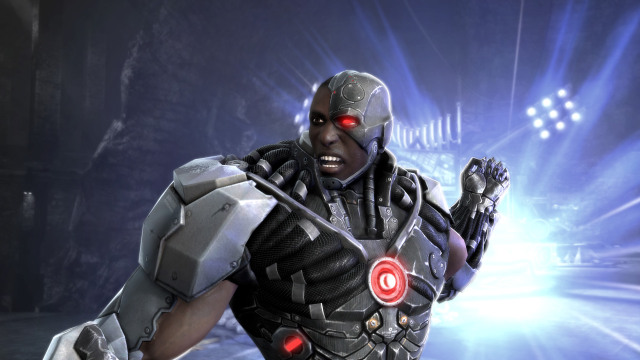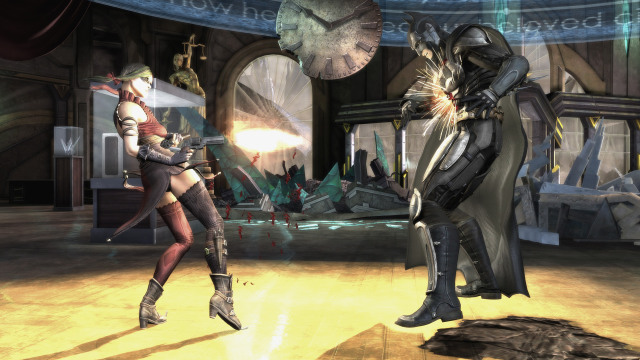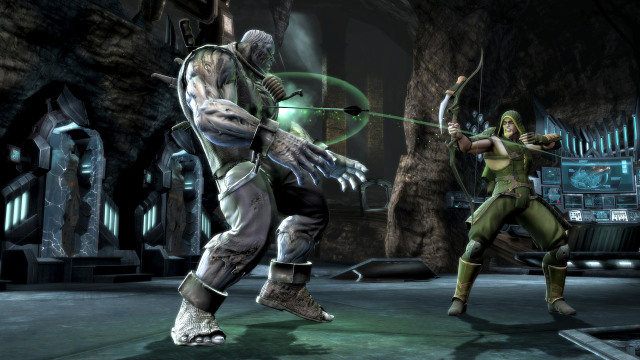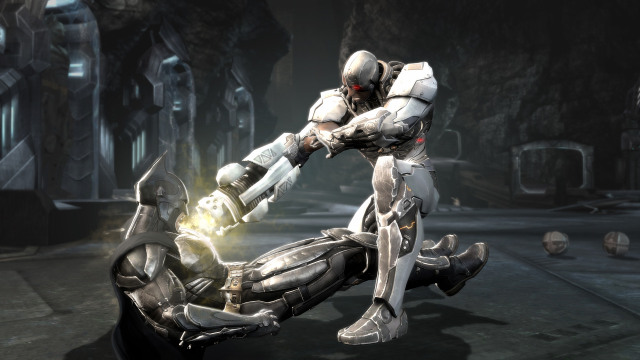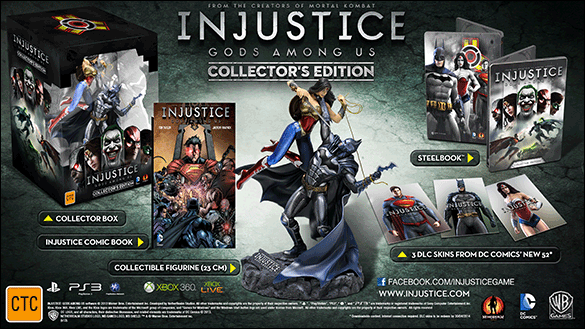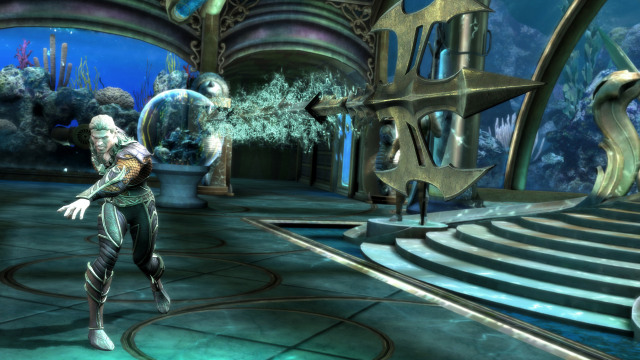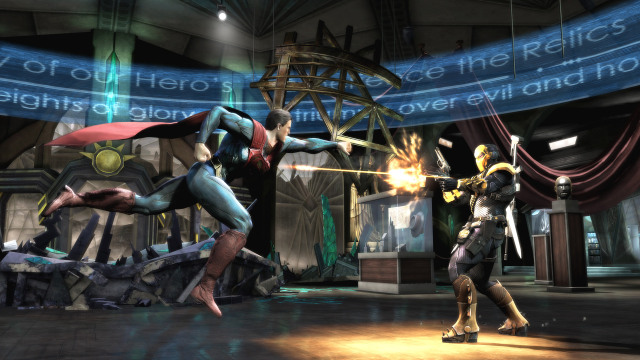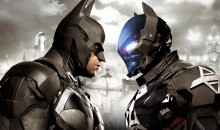Injustice: Gods Among Us is a fighting game based upon the fictional universe of DC Comics. The game was developed by NetherRealm Studios and published by Warner Bros. Interactive Entertainment for the PlayStation 3, Wii U, and Xbox 360. It was released in April 2013 in North America, Europe, and Australia, and June 2013 in Japan. An iOS variation of the game was released on April 3, 2013.
The game play for Injustice: Gods Among Us involves one-on-one matches within a two-dimensional plane, although characters and backgrounds are rendered in a three-dimensional fashion. Each match consists of one round; however, each player has two health bars. The game uses a four-button control layout of light, medium, and heavy attacks, alongside a “character trait” button that activates a unique ability or attack designed to showcase each character. For instance, Superman’s trait provides a temporary stat boost, while Batman’s trait summons a swarm of robotic bats. Ed Boon, the creative director of NetherRealm Studios, stated that characters roughly fall into two categories: power characters, who rely on brute strength and innate abilities, and gadget characters, who use weapons, items, and other external mechanisms to win.
The stages, based on locations such as the Batcave, Watchtower, and Fortress of Solitude, feature interactive environments and multiple tiers. Successfully connecting a heavy attack near the edges of the stage will launch the opponent into another part of the level. Each arena contains objects that the characters utilize differently depending on their class. For example, a gadget character like Batman can attach a bomb to a car to cause an explosion, while a power character like Superman can pick up the same car and smash his enemies with it. Players have the option to turn off interactive elements.
During combat, players charge their character’s super meter by performing combos or getting hit by the opponent. Portions of the super meter can be used for performing enhanced special moves or countering enemy moves. With a full meter, players can unleash their strongest special attack. Players may also expend meter to compete in wager battles, dubbed the Clash system, which combines individualized cutscene cinematics with the process of betting meter. A clash may be used to interrupt an opponent during a combo, and each player can only use it once after losing their first health bar. During the sequence, both players commit portions of their meter in secret, with the highest bidder winning the clash.
The story mode is split into several chapters. As the narrative plays out, the player swaps between different characters. Minigames are also incorporated into the story. The outcome of minigames can impact an upcoming battle, such as giving the player a health advantage over the CPU opponent. Additional features include Battle Mode, Versus Mode, Training Mode, and S.T.A.R. Labs, which includes 240 character-specific challenges of varying difficulty. Online multiplayer modes include King of the Hill, a setup that allows up to eight players to spectate a match while waiting for their turn to fight, and Survivor, which carries over the current winner’s health bar and character selection over each match. Playing through any of the game’s modes, including online matches with optional goal objectives, will net the player experience points that may be used to unlock alternate costumes, music, concept art, and other rewards.
When it comes to superheroes-turned-street fighters, DC Comics’ stable of superfriends have always received the short end of the stick. While Marvel enjoys the steady success of Capcom’s legendary Vs. series, the likes of Justice League Task Force and Mortal Kombat vs. DC Universe have not done DC any favors. Injustice: Gods Among Us, the latest fighter from the house of Mortal Kombat, aims to break this combo with a fighting system that builds upon the lessons of MK, while also introducing a few new tricks. But for all its complexities, Injustice unfortunately falls short when compared to its contemporaries.
If you are familiar with Mortal Kombat, you will feel right at home in Injustice. Character movement has that same deliberate, staccato style that’s distinct from the fighting genre’s Japanese-developed counterparts. That style feeds into the satisfying weight and brutality of each attack, whether it’s Bane breaking you over his knee or Hawkgirl taking her mace to your face. Controlling these characters feels powerful, and the destruction you bring upon your opponent and the environment add excitement to each fight.
While MK and Injustice have a similar feel, their underlying mechanics are very different. Injustice has three attack buttons and a special trait button. Whether it’s flight, healing, or a simple strength boost, these traits are unique to each fighter and play into their particular abilities and histories. The distinctions are clearly apparent, and don’t just boil down to slightly altered punches and kicks.
Clashes are another interesting mechanic. When activated, they instantly interrupt a combo, and then both players secretly spend an amount of their super meter. If the fighter who initiated the clash spends more, he regains health proportional to the amount spent; otherwise, he takes damage proportional to what his opponent spent. Clashes can be used only once per round, per character, and only if the initiator is down to his second health bar. The threat of a clash adds an interesting dynamic to the back half of a fight. It forces you to constantly reevaluate how much meter to save and spend based on what your opponent has stored.
Injustice does not have rounds. Instead, you have two health bars, and when they run out the match is over.
While clashes are only a two-time threat, Injustice’s interactive backgrounds are a constant hazard. Peppered throughout each stage are items–a missile here, a motorcycle there–for characters to use. Different characters use these items in different ways. Some use these objects as weapons to be smashed over an opponent’s head, while others use them as springboards to quickly navigate the arena. These items are a fun way to augment your fighter’s arsenal and take stage awareness to a new extreme. Knowing that a combo could put your opponent near a deadly item might make you think twice before launching your assault.
It’s too bad that so many characters simply destroy these background objects. A stone tablet that Batman can spring off of to reach the other side of the screen, Superman just smashes. Superman–along with the game’s other heavyweights–smashes almost everything he touches. In some stages, it is too easy to smash all of the interactive objects early on simply to deny your opponent their functions. This is especially troublesome for characters with limited mobility options who need these items to compensate for their shortcomings.
The story in Injustice–while grand in scope–is also full of shortcomings. This lengthy tale presents a world where Superman has reached his limit after being tricked into murdering his pregnant wife and unborn child, thereby triggering a nuclear bomb–which was linked to Lois’ heartbeat–in the center of Metropolis. It is a premise so ridiculous it borders on parody, but it’s presented in all seriousness. The cracks quickly begin to show as this narrative labors under the weight of finding new reasons for characters to stand around punching each other. By the end, you’re left wondering how the game could treat this cornball story with such unblinking reverence.
If you’re new to fighting games, you’ll find Injustice’s educational options disappointingly sparse. An extremely basic tutorial runs first-time fighters through the fundamentals, and that’s it. There’s a practice mode, but any information on fighting game theory or character-specific instructions is left to independent study. The S.T.A.R. Labs missions, Injustice’s version of MK’s challenge tower, offer some character-specific instruction, but are more of an enjoyable distraction than a way to prepare for real combat.
To further compound the confusion, other, lesser features are left completely unexplained. Tucked away in the controller settings menu are options for release check and alternate control. Both can significantly impact how you play, but you are on your own to figure out how. The largest omission lies in the frame data. This data provides useful insight into the properties of each move, but unless you know what startup frames and block advantage are, it’s not going to do you much good. And, once again, the game offers zero insight.
Despite numerous new systems and additions, Injustice is still perhaps a bit easier to get into than other fighting games, and loose enough that it’s very likely to be broken wide-open by hardcore players. The important thing is that the pieces fit together in a way that works. Small improvements and a willingness to experiment make Injustice feel like another small step down the path to a tournament-worthy game.
Online, Injustice offers the basics of player and ranked matches, along with the option to practice online with a friend. Player match options let you fight one-on-one, in a king-of-the-hill style or a survival mode. Unfortunately, replay support is a glaring omission. While players in the same lobby can spectate matches, there is no way to record and replay other fights. Replays can offer fantastic insight for players of all skill levels on how to play their favorite fighters, but their absence further compounds Injustice’s educational deficiencies. Matches against opponents within a three- or four-bar connection range run without serious delay. However, falling below this connection range can cause some noticeable lag between inputting a command and having it appear in the game.
Leveling up your account unlocks music, concept art, and costumes.
DC Entertainment and Warner Bros. have announced a special collector’s edition set for Injustice: Gods Among Us and our Batman underpants may be showing, but we think the set looks pretty spectacular.
• Exclusive 25cm Injustice: Gods Among Us collectible statue featuring iconic characters Batman and Wonder Woman
• Unique Steelbook Packaging
• An Injustice Comic Book
• Three exclusive skins based on Batman, Superman and Wonder Woman from DC COMICS – THE NEW 52
This set is rather fancy, if we do say so ourselves.
Obviously the collectible statue is the main reason for getting this set, but the other bonuses are rather fancy as well, especially the steelbook packaging. The prequel comic which sets up the premise of Injustice: Gods Among Us can be purchased seperately via DC’s own digital comic store, so if you’re a nut for story then you have options other than this special set.
Unfortunately UK retailers have yet to list this special edition of Injustice: Gods Among Us on their respective sites, but when they do we’ll be sure to list them in our dedicated product pages
Injustice: Gods Among Us is a hard-hitting fighter that plays to the hardcore crowd. Its creative use of background objects coupled with satisfying fighting mechanics make it both fun and distinct from it contemporaries. But for newer players, the minimal instruction modes and disappointing story provide little incentive for your sustained interest. And the absence of replay support is a loss for everyone involved. Injustice is an enjoyable fighter but as a whole, the package is found wanting.
In some ways, I think, Injustice feels like a sequel to Mortal Kombat that’s swapped in one group of costumed combatants for another. The chunky animation style of older Mortal Kombat games can make these heroes seem alternately super-powerful or super-awkward, and the NetherRealm look doesn’t fit every character — Wonder Woman can only be described as a victim of the aesthetic. But this is really a minor complaint for a very playable and easily enjoyable fighter. There’s a lot to appreciate here, and many good fights to be had — Injustice actually does justice to its source material and its players.

